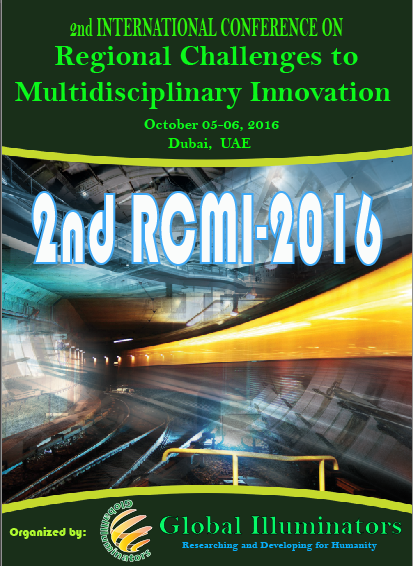
RCMI Proceedings
RCMI Proceeding
Volume 2, Pages 1-36
2016 RCMI Conference on “REGIONAL CHALLENGES TO MULTIDISCIPLINARY INNOVATION ” (RCMI 2016)
October 05-06, 2016 Dubai, UAE
Edited by Dr. Ahmed Saddam
pp. 1-83 (2015)
2015 RCMI Conference on “REGIONAL CHALLENGES TO MULTIDISCIPLINARY INNOVATION ” (RCMI 2015)
pp. 1-36 (2016)
2016 RCMI Conference on “REGIONAL CHALLENGES TO MULTIDISCIPLINARY INNOVATION ” (RCMI 2016)
Track: Social Science & Humanities
ITIL: Implementation and Service Management Best Practices in Malaysian Academic Libraries
Pages 1-9
Zainab Ajab Mohideen, Kiran Kaur, Sukmawati Muhamad, Noor Azlinda Wan Jan, A
Basheer Ahamadhu
Abstract
Reconstructing ‘Batu Nong’ and Gender Relations in Indonesia
Pages 10-14
Clara Evi Citraningtyas
Abstract
Re-hardwiring the Cultural and Philosophical Infrastructure of Iran for a Better Management
Pages 15-22
Samin Rezaei
Abstract
An Analysis of Gulf College Students’ Discourse Skills Using Hoey’s Model
Pages 23-29
Cuarteros, Joseph Bangayan
Abstract
This study attempted to assess the development of the discourse skills of the Faculty of Foundation Studies, Gulf College as second
language learners. Using Michael Hoey’s model, this paper specifically tried to identify the discourse skills of the respondents, the level
which these discourse skills become systematic and how these discourse skills develop. This research paper used the longitudinal descriptive
method in identifying the acquisition of the various discourse skills which are reflected in the final examination of the respondents at three
levels (PRE-IFP, Semester 1 and Semester 2.The model proposed by Hoey (1983) follows the pattern: Situation- Problem-Response-ResultEvaluation. Based on the result of the study, there is invariant sequence of the discourse structures of the students. The discourse structures
acquired systematically by the respondents we situation, problem and response. On the other hand, the signals for both result and evaluation
are variable across programme levels. The structures of narratives such as result and evaluation cannot be considered to have been acquired
as far as discourse pattern is concerned. This study concluded that the learners’ acquisition of Hoey’s structure of narratives follows the
natural order of development. The analysis of the written narratives of the respondents uncovers how the learners demonstrate their
competence and the deliberate choices they make in response to the communicative situation. It is very apparent that acquisition increases
with programme level as evident in the narrative structures such as situation, problem and response. These narrative structures become
systematic among the PRE-IFP level while result and resolution become systematic at Semester 1 and Semester 2 respectively.
Track: Health and Medicine Studies
Influence of Core Stabilization on Strength of Hip Abductor in Standing
Pages 30-36
Oh-yun Kwon, Jeon Incheol, Ui-Jae Hwang, Sung-Hoon Jung, Jun-Hee Kim
Abstract
Core stabilization has been emphasized for managing chronic lower back pain and improving standing balance. This study was performed to investigate the influence of core stabilization on hip abductor muscle performance in the standing position.A parallel-groups design. University research laboratory. A sample of 34 subjects with and without core stabilization between 20 and 31 years of age.Hip abductor strength was measured using a tension meter, the Smart KEMA System, with and without core stabilization between the subjects. Two groups were classified using the double bent leg lowering test. The strength of the hip abductor muscles were evaluated in standing, both with and without an external support condition. The intra-rater reliability of the repeated measures was estimated by calculating the intra class correlation coefficients (ICC).The hip abductor strength in standing was higher with external support in the group without core stabilization than in the group without external support (p < 0.05). There was no significant difference in the hip abductor strength in the subjects with core stabilization between conditions, with or without external support (p > 0.05). The intra-rater reliability of the hip abduction testing without external support was higher in standing in the group with core stabilization than in the group without core stabilization (ICC = 0.93 with core stabilization and 0.80 without core stabilization). In the group without core stabilization, the intra-rater reliability with an ICC (3, 1) of the hip abductor strength measurement with external support was higher than without external support (ICC = 0.98 with external support and 0.80 without external support).The performance of the hip abductor strength in standing can be influenced by core stabilization. In the group without core stabilization, the hip abduction performance in standing is better with external support, as compared to the condition without external support. Therefore, core stabilization training can be recommended in individuals without core stabilization to improve the hip abductor performance in standing. To confirm core stability, the measurement of the hip abductor strength in standing should be performed separately in conditions both with and without external support. Core stabilization training may be needed to improve hip abductor performance in standing.
